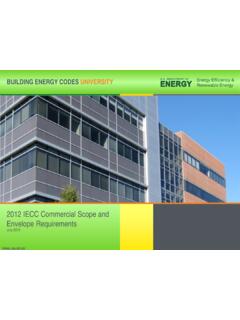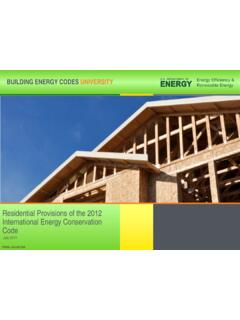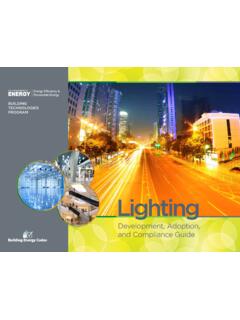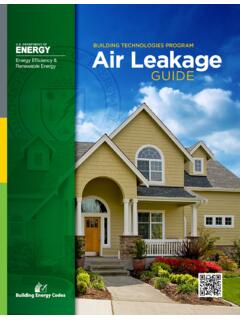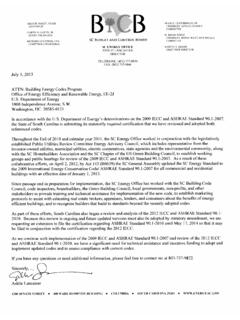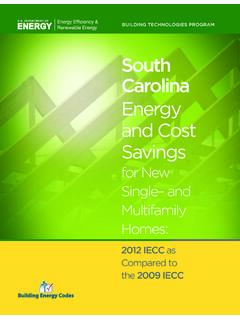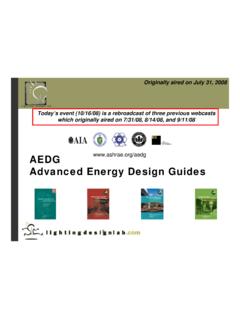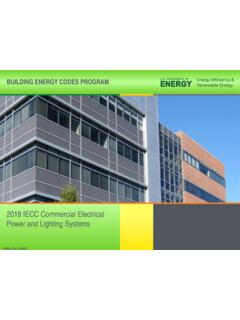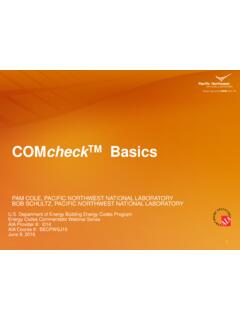Transcription of ANSI/ASHRAE/IESNA Standard 90.1-2007 An Overview of …
1 1 ANSI/ASHRAE/IESNA Standard Overview of the Lighting and Power RequirementsJanuary 10, 2008 Eric Richman, LCPacific Northwest National Laboratory2 The Department of Energy is a Registered Provider with The American Institute of Architects Continuing Education Systems. Credit earned on completion of this program will be reported to CES Records for AIA members. Certificates of Completion for non-AIA members are also program is registered with the AIA/CES for continuing profession education. As such, it does not include content that may be deemed or construed to be an approval or endorsement by AIA of any material of construction or any method or manner of handling, using, distributing, or dealing in any material or product.
2 Questions related to specific materials, methods, and services will be addressed at the conclusion of this presentation. 3 The Basis for Energy Requirements Energy Conservation and Production Act, as amended by EPAct, requires States to adopt a commercial energy drives state adoption of energy codes DOE determines the effective stringency level to meet or exceed Many code/ Standard versions available and currently adopted varies by state: Some adopt nationally available codes/ standards Some develop state-specific codes Some have no code!4 Status of Commercial Energy Codes as of Jan. 1, 2008 ashrae IECC, equivalent or betterASHRAE IECC or equivalentASHRAE IECC or equivalentASHRAE IECC or equivalentNo statewide codeOlder than ashrae IECCA doption by county/jurisdiction**American SamoaGuamN.
3 Mariana IslandsPuerto Virgin Islands**5 Standard Basics Jointly sponsored by ashrae and IESNA 2007 is the brand new many states have other versions of in place (2004, 2001, 1999, 1989) Many State-specific codes and the IECC are based on IECC references as compliance option 6 Building Power Requirements Voltage Drop: Feeder conductors Run between the service entrance and the branch circuit 2% maximum voltage drop allowed Branch circuit conductors Run from the final circuit breaker to the outlet or load 3% maximum voltage drop allowed7 Building Power Requirements Document submittals: owner gets information about the building s electrical system Record drawings of actual installation within 30 days Single-line diagram of electrical distribution system Floor plans showing location of distribution equipment and areas served by equipment Manuals Submittal data stating equipment nameplate rating O&M manuals for equipment Qualified service agency Complete narrative and schematic of system as it s normally intended to operate8 Standard Lighting Scope New Construction and Additions All commercial type buildings including residential structures of 4 or more stories above grade Interior and exterior
4 Lighting Some exceptions to all requirements: Lighting in dwelling units Emergency lighting that is normally off Lighting required by life, health, safety statute Historic buildings (whole code exemption) Alterations/Renovations Generally treated as new construction Some exemptions apply9A Few Words About Alterations/ Renovations The requirements are effectively the same as for new construction or additions: The replacement of lighting systems in building spaces must comply Any new or replacement control devices must comply Exception: Replacement of less than 50% of the luminaires in a space need not comply (if no increase in power density)10 ExemptionsBasic Lighting RequirementsMandatory Requirements (Interior and Exterior)ControlsSwitchingInterior Lighting Power LimitsWhole BuildingAdditional Allowances+EfficiencySpace-by-SpaceExemp tionsExterior Lighting Power Limits+Total Connected PowerInterior Lighting Power Allowance<ORTradableNon-TradableTotal Connected PowerExterior Lighting Power Allowance<11 Mandatory.
5 Individual Space Control At least one for each room or space enclosed by ceiling-height partitions in spaces 10,000 ft2, each control serves 2500 ft2 maximum and in spaces > 10,000 ft2, serves 10,000 ft2maximum Readily accessible to occupants Remote location is allowed to accommodate areas where safety or security is a concernIntent: Allow occupants to control unneeded lighting12 Mandatory: Additional Space Controls Hotel/motel guest room lighting must be controlled at room entry Occupancy sensors are required in: Classrooms (except shop, lab, K-12) Conference/meeting rooms Employee lunch/break roomsIntent: Allow occupant to turn off lights at exit pointIntent: Capture major occupied hours wasted light13 Mandatory: Individual Space Control Additional control required for: Display/accent lighting Case lighting Task lighting Nonvisual lighting Demonstration lightingIntent: Provide opportunity to turn off special application lighting14 Mandatory: Automatic Shutoff Automatic lighting shutoff control device required in all buildings larger than 5,000 ft2 Override of automatic shutoff required for not more than 4 hours Exceptions to automatic shutoff.
6 Lighting for 24-hour operation Patient care spaces Areas with safety or security concernsIntent: Eliminate after hours lighting waste15 Mandatory: Automatic ShutoffCompliance options:1. Control lights on a scheduled basis (automatic time switch) Time-of-day controller Controls 25,000 ft2and not more than one floor 2. Occupant sensor Turn lights off within 30 minutes of occupant leaving the space3. Signal from another control or alarm that indicates the area is unoccupiedNOTE: earlier versions include faulty occupant intervention phrase16 Application of Automatic ShutoffIntent is to apply to business entities or structures where whole building control is practicalExample application: Strip mall individual business unit17 Mandatory: Exterior Lighting Control For dusk-to-dawn lighting: astronomical time switch or photosensor For all other: astronomical time switch OR photosensor + time switch [REVISED!]
7 ] All time switches must have 10 hour battery backup Exceptions: Covered vehicle entrances Exits from buildings or parking structures(where required for safety, security, or eye adaptation)Intent: Eliminate exterior lighting left on during the day18 Mandatory: Tandem Wiring/Exit Signs Tandem wiring: eliminate use of single lamp, low-frequency ballast where possible Exit signs: limited to 5 watts per face maximumIntent: Eliminate use of low-frequency ballasts driving single lamps19 Prescriptive: Interior Lighting Power Prescriptive Option Whole Building or Space-by-space method Compare actual Installed Power(wattage) to Lighting Power Allowance(lighting power density LPD) limits Additional power allowances and exemptions available A few words about the Performance Option Energy Cost Budget Whole building energy use modeling Compare prescriptively compliant base building with proposed building Can provide flexibility but requires detailed modeling inputsIntent: Eliminate waste by promoting thoughtful design and application20 Prescriptive.
8 Determine Installed Power Calculate installed lighting wattage for all interior lighted space(s) Include all permanent and portable interior lighting designed for general, ambient, or task illumination Exception: for 2 or more mutually exclusive lighting systems only count the system with highest wattage21 Prescriptive: Determine Installed Power Wattage Calculation Rules Standard incandescent = maximum labeled wattage of the luminaire Luminaires with ballasts or transformers = wattage of the maximum lamp/ballast combination not just nominal lamp wattage! OR the maximum labeled wattage of the luminaire [NEW!] Line voltage track = actual wattage with minimum 30 W per foot OR the wattage limit of the system s circuit breaker [NEW!]
9 ]OR the wattage limit of other permanent current limiting device(s) on the system [NEW!] Low voltage track = transformer wattage All others as specified on equipment22 Prescriptive: Wattage Exemptions Lighting for the following can be excluded: Theatrical, stage, film, and video production Used only during medical and dental procedures Display/accent in exhibits/displays for museums, monuments, and galleries Plant growth or maintenance Integral to equipment or instrumentation installed by manufacturer Integral to both open and glass-enclosed refrigerator and freezer cases Food warming and food prep equipment In retail display windows when the display is enclosed by ceiling-height partitions Lighting in spaces specifically designed for use by occupants with special lighting needs including visual impairment and other medical and age related issues.
10 [REVISED!] In spaces specifically designated as registered interior historic landmarks Integral part of advertising or directional signage Exit signs Sale or lighting educational demonstration systems For television broadcasting of sporting activities Casino gaming areas Furniture-mounted supplemental task lighting controlled by automatic shutoff [NEW!]23 Prescriptive: Lighting Power Allowance Choose appropriate Lighting Power Density (LPD) Whole Building Path Easier Less flexibility Space-by-Space Path More math Often higher potential total allowance Multiply LPD by square footage Whole building LPD times total building area Space-by-space LPD times space area(s) and sum valuesOffice ACorridorStorageRetail SalesOffice BTotal Building Area = 3000 ft2 Rest-rooms24 Spa
